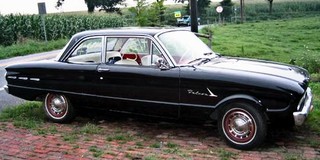 The 1961 in the title is something of a guess. I know for sure it was a first generation Falcon Futura. The first generation of Falcons ran from 1960 through 1963 with the bucket-seated Futura introduced in 1961. I believe mine was a ’61 but I guess it’s possible it was a year or two newer. If, however, you judged the car’s age purely on its condition, you would be challenged to believe it was a maximum of ten years old when I bought it in 1971 for $35.
The 1961 in the title is something of a guess. I know for sure it was a first generation Falcon Futura. The first generation of Falcons ran from 1960 through 1963 with the bucket-seated Futura introduced in 1961. I believe mine was a ’61 but I guess it’s possible it was a year or two newer. If, however, you judged the car’s age purely on its condition, you would be challenged to believe it was a maximum of ten years old when I bought it in 1971 for $35.
When the Dodge went off to get its transmission fixed, I needed transportation for a couple of weeks. A friend of a friend had a friend with a car for sale that might make it that long. No guarantee, of course. At some point in its life, my car must have looked like the dark blue ’61 in the photo but it wasn’t on my watch. There was no evidence of a major collision but there had obviously been plenty of small ones and rust was a major player in the color scheme. The interior was a trifecta of torn, shabby, and faded. I remember that all or most of the fancy Futura console was present but it was not actually attached to anything and sort of bounced around the drive shaft hump as it saw fit.
The first problem I had was getting the title transferred. The seller was a college student from Louisiana. He had lived in Cincinnati for a few years but, because license, taxes, or something else cost more in Ohio, had never transferred the title. When I went to a title office in Ohio, I was turned away because of some time limit. Then someone suggested that if we got the title notarized out of state, we might get away with claiming it was done while the guy was on the way to Ohio to deliver the car. We found a cooperative notary in Kentucky then got a new title in Ohio without a hiccup.
The Falcon did its job until the Dodge came back then stayed around in a part time role. At that point in my life, I knew lots of people with cars that were not 100% dependable and who might need a loaner now and then. The Falcon was almost perfect for this since it did provide the desired function but did it in such a way that no one was tempted to delay the repair of their own car any more than necessary. The car met its demise while on loan.
One of the car’s many quirks was a temperamental ignition interlock. The transmission was a column shift automatic. Like most cars of the day, the Falcon’s transmission had to be in “park” in order to start the car. More often than not, it had to be extra deep in “park”. ‘P’ was all the way to the left; reached by pushing the lever up. When I got the car, the cast metal casing was already cracked from all the shoving on the lever to get the starter to engage. The crack grew. The car’s last driver had the lever come off in his hand as he pressed it upward. I retrieved the plates, left the signed title in the glove box, and waved goodbye to the best $35 car I ever owned.
Previous Wheels: Chapter 11 — 1967 Dodge
Next Wheels: Chapter 13 — 1966 Suzuki

This sort of thing appeals to me: the cheap but serviceable car, to be used as a backup.
“Cheap but serviceable” describes it quite well though I’m sure some would question the “serviceable” part.